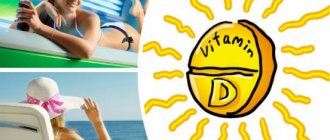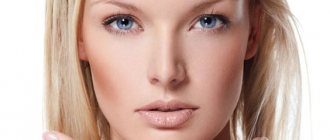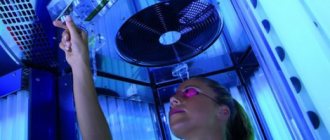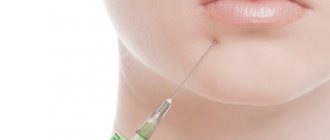Hi all! In this article I talk in detail about what self-tanning is and how to choose it, and I will also give a rating of the best ones.
In modern society, a beautiful body is associated with a golden or bronze skin tone, but not everyone is able to get out to the sea in the summer and soak up the southern rays of the sun.
To achieve instant results, many women turn to a solarium for help. It is, of course, both more comfortable and effective, but unlike self-tanning, it has a huge number of contraindications:
- diseases of the cardiovascular system;
- hypertension;
- asthma;
- blood diseases;
- thyroid gland;
- varicose veins
Also, some doctors associate this cosmetic procedure with the development of malignant skin tumors - melanoma.
Of course, tanning on the beach has always been beyond competition; it helps the body produce endorphins (a group of polypeptide chemical compounds that can reduce pain and affect the emotional state), the formation of vitamin D3, which is necessary for bones, nails, and hair.
However, just like a solarium, it has some negative aspects: sunburn of the skin can cause the development of melanoma, photodermatitis, chloasma, photoaging, exacerbation of chronic diseases (cardiovascular, gynecological diseases and diseases of the digestive tract, hypertension).
However, not everything is so scary, and self-tanning will help you achieve the desired skin tone - an excellent modern product that allows every woman in winter and summer to please herself with a chic bronze, golden or chocolate skin tone.
Such cosmetic products now exist in a wide variety of forms: milk, spray, cream, lotion, gel, tablets, etc. All this confuses a beginner who has decided to use self-tanning, and what effect these products have on the skin also remains unknown.
How does self-tanning work?
Self-tanning contains chemical elements and pigments that color the stratum corneum of the skin. One of the main components is Dihydroxyacetone. When in contact with skin keratin proteins, it has an active effect on the skin. This produces melonoidin, which is somewhat similar to melanin. As a result, a tan becomes noticeable on the skin.
Previously, the substance was prescribed to people who had diabetes, but in the 60s it was proven that the substance affects skin color. Manufacturers developed microparticles - bronzes, due to which the skin had a shimmering effect.
Chemistry lessons
The main active component of self-tanning products is the DHA molecule, scientifically called dihydroxyacetone.
By entering into a chemical reaction with skin cells, it colors the upper layer of the epidermis in a brown tint that imitates a tan. “Dihydroxyacetone is a carbon sugar. This component was first used in 1920 as a glucose substitute. In 1959, one pediatrician noticed that if this substance gets on the skin, it turns dark, and they began to use it for commercial purposes,” says Oksana Chashchina, a medical dermatocosmetologist, making an excursion into history. The principle of operation of DHA is simple: the molecule stains only the superficial cells of the epidermis, keratinocytes. This superficial effect of self-tanners allows many doctors to be confident in their safety. “Keratinocytes are located where there are no blood vessels, so the molecule does not enter the general bloodstream of the body. Another positive point is the natural origin of the DHA molecule, it is obtained from sugar cane. It is important to remember that after applying self-tanning, the skin cannot lighten on its own - it can only peel off, as with a natural tan,” says Maria Bondareva, a dermatologist and cosmetologist at the Remedy Lab clinic.
Types of self-tanning
Bronzers and bronzers
Self-tanning products of these types contain a large amount of coloring substances. Tanning occurs as a result of skin coloring. These products make it possible to quickly enjoy your tan.
It is important to take into account the disadvantages of the products - the paint is unstable, if it gets on clothes, it immediately stains it. Also, the skin loses its attractiveness and becomes spotty.
When using bronzers, be sure to follow these rules:
- The color should not be too dark.
- Choose a color a shade or two darker than your skin tone.
- The gel is applied to the face and body, where the sun's rays are most affected.
- It is better not to darken the neck.
Accelerators
This component increases the amount of pigment in the skin. A popular accelerator is Tyrosine. The amino acid takes part in the synthesis of melanin. When it is on the skin, the tanning process accelerates. You can buy spray, cream, milk.
Self-tanning: features and benefits
Not all girls are ready to lie in the sun for hours, achieving a bronze skin tone.
In addition, a long stay on the beach is dangerous, it provokes excessive dryness, irritation and, worst of all, melanoma. The reputation of solariums is also far from ideal; moreover, the tan obtained in them has an unpleasant grayish tint. Modern self-tanners can save fashionistas who want to acquire a beautiful skin tone and do not want to put their own health at risk. These products are available in a huge range. On sale there are preparations for the face and body, products in the form of cream, gel, balm, spray, liquid and even leaves soaked in special coloring powder. When choosing the right product, you should focus on your skin type, its color, personal preferences and brand reputation. Ratings of car bronzers are regularly published by glossy magazines; interesting new products are released annually.
You don’t have to buy the most expensive auto bronzer; there are decent products in all price categories.
High-quality auto-bronzant:
- allows you to get a spectacular tan in just a couple of hours;
- gives the skin a beautiful shade of desired saturation;
- does not leave burns or damage;
- fights dryness, wrinkles, peeling, nourishes and moisturizes the skin;
- goes away gradually;
- can be easily removed using available means (scrubs, scrubs).
Artificial tanning products from leading manufacturers have undergone multi-stage testing and are absolutely safe for the skin. Contraindications will be individual intolerance to the components, breastfeeding and some endocrine diseases.
Autobronzant is a safe alternative to the beach and solarium.
Despite many advantages, self-tanning products also have disadvantages:
- most products have a specific, not very pleasant aroma that is not drowned out by perfume fragrances;
- It is difficult for a beginner to apply the composition in hard-to-reach places; an assistant may be required to treat the back;
- some products leave stains on clothes and bedding;
- artificial tan needs to be renewed every 3-5 days.
Recommendations for using self-tanning
- The product is first thoroughly treated with a scrub, with which you can get rid of dead skin particles. This will make your tan last much longer.
- If you remove excess hair using a razor, you must complete all procedures before applying self-tanner.
- Be sure to use gloves when applying the product to protect your hand skin.
- Are you blonde? Be very careful when applying self-tanner near your hair, otherwise it will turn brown or beige.
Statistics show that it is most convenient to use a cosmetic product with a spray. Then you need to distribute it evenly over the skin. Some women use self-tanning only for the face, décolleté, and hands. You can do that, just be careful not to look like a spotted leopard.
Contraindications and precautions
The main contraindications to the use of self-tanning are:
- Allergy.;
- Herpes;
- Dry skin;
- Cuts, injuries, damage, skin diseases (dermatitis, psoriasis, eczema, etc.).
Self-tanning should be used with great caution during pregnancy. Although pregnancy is not a contraindication, you need to choose a cosmetic product more carefully and follow all recommendations for use.
The same applies to established mothers who breastfeed their babies. Self-tanning will not cause any harm to the baby, but you should not use an untested product either.
How harmful is self-tanning to the skin?
Please note that if you use all cosmetic products correctly, they will not cause harm. Some people say that self-tanning causes skin dehydration. This deficiency is easily eliminated with the help of cosmetic oil or milk. The main danger of self-tanning is that it does not have protection from ultraviolet rays.
Of course, some manufacturers have some sun protection filters, so it's important to look at the packaging when choosing a self-tanner. The SPF filter should be indicated there.
When using, it is important to consider that this is a synthetic product. It has benefits. Before using self-tanner, you need to think carefully:
- Self-tanning contains alcohol, so it can lead to dry skin. Additionally, you need to use moisturizers.
- The product causes a serious allergic reaction. To do this, you need to apply a little product on your wrist. If redness, itching or rash occurs, self-tanner should not be used.
- The main component dehydroxyacetone dehydrates the skin, so it is additionally necessary to use skin moisturizers.
- A product that does not dry will greatly stain clothes.
- Self-tanning clogs the pores of the skin, so it can't breathe.
Benefits of a solarium
The main advantages of a solarium:
- You can visit the solarium at any time of the year and do not need to travel to warm countries.
- Solariums use artificial ultraviolet rays, which have a similar effect to the sun's rays.
- In a solarium you can get a healthy dose of vitamin D, which is responsible for the strength of the musculoskeletal system.
- In just a few sessions you can get a beautiful tan without the sun.
- The tan lasts on the skin for several months if you care for it properly.
- The duration of the procedure does not exceed 10 minutes. Two to three sessions per week are enough to achieve the desired result.
Which is better to choose: self-tanning or solarium?
Many people ask how harmful these procedures are and what is better to choose. In a solarium, you are exposed to ultraviolet lamps, which lead to the destruction of collagen and elastic. It immediately loses elasticity and is unstable to various environmental factors.
Self-tanning and solariums dry out the skin and cause significant burns. If you use instant tanning for a long time, you can end up with skin cancer. Due to the fact that the stratum corneum thickens significantly and does not allow oxygen to pass through, blockage occurs, so the skin quickly ages and loses its attractiveness.
Thus, it is up to you to decide whether to use self-tanning or not. Indeed, it has its pros and cons. Analyze them carefully and make the right decision. Of course, you shouldn’t get carried away with procedures; it’s better to prefer tanning in the sun. But also know when to stop, because ultraviolet rays have a negative effect on the skin and can lead to melanoma.
I have a question
It would seem that self-tanning only causes a simple chemical reaction on the skin - a natural tan is sometimes much more dangerous, many experts agree with this.
However, the opinion of some dermatologists is not so clear. “Let me remind you that dihydroxyacetone, the main component of most self-tanning products, is a carbon sugar, and the change in skin color that it triggers is nothing more than the process of glycation of epidermal proteins with DHA. In turn, glycation of proteins is one of the factors influencing the aging of the body, therefore glycation of surface proteins of the skin, in fact, leads to aging of the skin, since proteins, the building material of the whole body, become fragile and their functions are impaired,” warns dermatocosmetologist Oksana Chashchina (medical). Of course, the irreversible process of glycation in skin cells is caused not only by self-tanning, but also by a number of other, more aggressive factors, the most obvious of which is the uncontrolled consumption of sugar in food. In both cases, doctors advise taking restrictive measures - monitoring the amount of sugar in the diet and not using self-tanners on a daily basis.
Another common myth about self-tanning is its possible involvement in the occurrence of skin cancer. Doctors refute the popular belief: “This is in no way supported by a scientific evidence base,” states Maria Bondareva, a dermatologist at the Remedy Lab clinic. “Skin cancer, as a rule, is genetically determined, so it cannot be directly linked to the use of self-tanning. However, everything you inhale, eat, or apply to your skin goes through all the detoxification cycles in your body. Its possibilities are not unlimited, so toxic substances can accumulate in target organs, for example in adipose tissue. Also, at present, no scientific research has been conducted on the effects of dihydroxyacetone on humans,” sums up medical dermatocosmetologist Oksana Chashchina.
Salon tanning
Those who do not want to bother with auto-bronzants themselves can resort to the salon tanning procedure. Its convenience lies in the speed of application - just a couple of minutes is enough, and you will get the desired bronze shade. Before the procedure, you will be exfoliated, and the spray system will ensure an even application of self-tanning, leaving no spots or streaks. Tanning shades vary: mountain, sea, tropical - to suit your taste. In addition, salon products are devoid of the specific smell of cosmetics, which some may find unpleasant.
Follow the basic rules for applying self-tanning:
- on the eve of the procedure, clean the skin with a scrub or a hard washcloth; on even skin and the tan will lie more evenly;
- Carry out the procedure in the morning, otherwise the self-tanner may smudge at night while you sleep;
- protect your hair, lips, eyebrows and nails, otherwise self-tanning will color them (you can cover them with a layer of rich cream and put a shower cap on your head);
- apply self-tanning to dry, clean skin, which should cool down after water treatments;
- Before applying self-tanning, use a moisturizer to keep your skin smooth, but be sure to let it absorb well for 10-15 minutes;
- Apply self-tanner using sliding circular movements on the body from bottom to top;
- Cover the natural folds of the body, knees and elbows with a very thin layer of self-tanning, and it is better not to touch the armpits at all;
- You won’t be able to treat your back on your own, it’s better to ask a friend for help;
- to avoid the effect of a mask on the face, work especially carefully in the transition area from the neck to the chin;
- Make sure that the skin tone is the same on different parts of the body - do not forget to apply self-tanner to your temples and ears.










